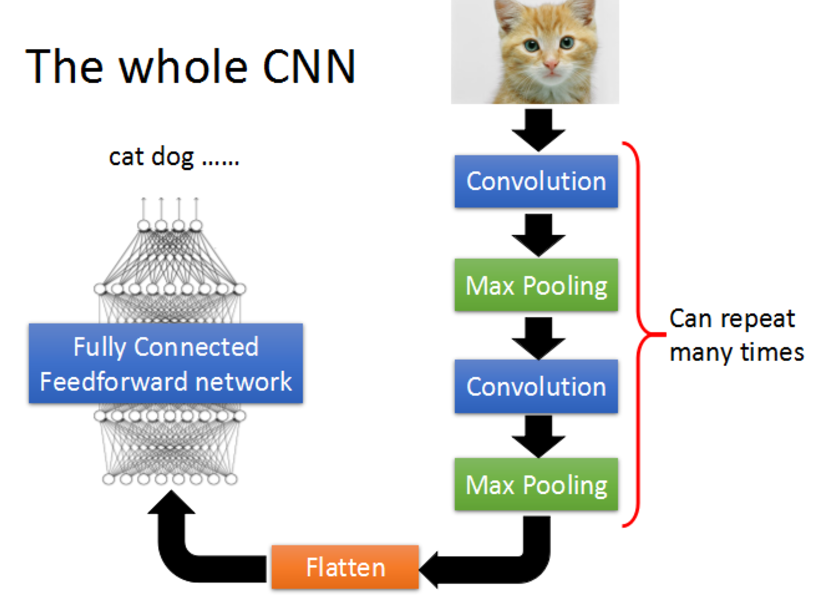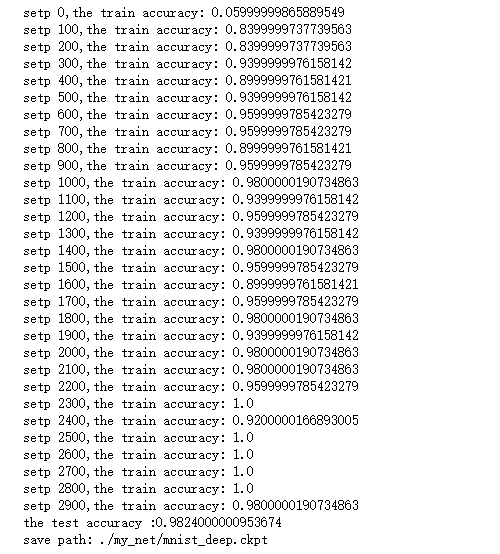TensorFlow是目前深度学习最流行的框架,很有学习的必要,下面我们就来实际动手,使用TensorFlow搭建一个简单的CNN,来对经典的mnist数据集进行数字识别。
如果对CNN还不是很熟悉的朋友,可以参考:Convolutional Neural Network。

下面就开始。
step 0 导入TensorFlow
1 import tensorflow as tf 2 from tensorflow.examples.tutorials.mnist import input_data
step 1 加载数据集mnist
声明两个placeholder,用于存储神经网络的输入,输入包括image和label。这里加载的image是(784,)的shape。
1 mnist = input_data.read_data_sets('MNIST_data/', one_hot=True) 2 x = tf.placeholder(tf.float32,[None, 784]) 3 y_ = tf.placeholder(tf.float32, [None, 10])
step 2 定义weights和bias
为了使代码整洁,这里把weight和bias的初始化封装成函数。
1 #----Weight Initialization---# 2 #One should generally initialize weights with a small amount of noise for symmetry breaking, and to prevent 0 gradients 3 def weight_variable(shape): 4 initial = tf.truncated_normal(shape, stddev=0.1) 5 return tf.Variable(initial) 6 def bias_variable(shape): 7 initial = tf.constant(0.1, shape=shape) 8 return tf.Variable(initial)
step 3 定义卷积层和maxpooling
同样,为了代码的整洁,将卷积层和maxpooling封装起来。padding=‘SAME’表示使用padding,不改变图片的大小。
1 #Convolution and Pooling 2 #Our convolutions uses a stride of one and are zero padded so that the output is the same size as the input. 3 #Our pooling is plain old max pooling over 2x2 blocks 4 def conv2d(x, W): 5 return tf.nn.conv2d(x, W, strides=[1,1,1,1], padding='SAME') 6 def max_pool_2x2(x): 7 return tf.nn.max_pool(x, ksize=[1,2,2,1], strides=[1,2,2,1], padding='SAME')
step 4 reshape image数据
为了神经网络的layer可以使用image数据,我们要将其转化成4d的tensor: (Number, width, height, channels)
1 #To apply the layer, we first reshape x to a 4d tensor, with the second and third dimensions corresponding to image width and height, 2 #and the final dimension corresponding to the number of color channels. 3 x_image = tf.reshape(x, [-1,28,28,1])
下面我们就要开始搭建CNN结构了。
step 5 搭建第一个卷积层
使用32个5x5的filter,然后通过maxpooling。
1 #----first convolution layer----# 2 #he convolution will compute 32 features for each 5x5 patch. Its weight tensor will have a shape of [5, 5, 1, 32]. 3 #The first two dimensions are the patch size, 4 #the next is the number of input channels, and the last is the number of output channels. 5 W_conv1 = weight_variable([5,5,1,32]) 6 7 #We will also have a bias vector with a component for each output channel. 8 b_conv1 = bias_variable([32]) 9 10 #We then convolve x_image with the weight tensor, add the bias, apply the ReLU function, and finally max pool. 11 #The max_pool_2x2 method will reduce the image size to 14x14. 12 h_conv1 = tf.nn.relu(conv2d(x_image, W_conv1) + b_conv1) 13 h_pool1 = max_pool_2x2(h_conv1)
step 6 第二层卷积
使用64个5x5的filter。
1 #----second convolution layer----# 2 #The second layer will have 64 features for each 5x5 patch and input size 32. 3 W_conv2 = weight_variable([5,5,32,64]) 4 b_conv2 = bias_variable([64]) 5 6 h_conv2 = tf.nn.relu(conv2d(h_pool1, W_conv2) + b_conv2) 7 h_pool2 = max_pool_2x2(h_conv2)
step 7 构建全链接层
需要将上一层的输出,展开成1d的神经层。
1 #----fully connected layer----# 2 #Now that the image size has been reduced to 7x7, we add a fully-connected layer with 1024 neurons to allow processing on the entire image 3 W_fc1 = weight_variable([7*7*64, 1024]) 4 b_fc1 = bias_variable([1024]) 5 6 h_pool2_flat = tf.reshape(h_pool2, [-1, 7*7*64]) 7 h_fc1 = tf.nn.relu(tf.matmul(h_pool2_flat,W_fc1) + b_fc1)
step 8 添加Dropout
加入Dropout层,可以防止过拟合问题。注意,这里使用了另外一个placeholder,可以控制在训练和预测时是否使用Dropout。
1 #-----dropout------# 2 #To reduce overfitting, we will apply dropout before the readout layer. 3 #We create a placeholder for the probability that a neuron's output is kept during dropout. 4 #This allows us to turn dropout on during training, and turn it off during testing. 5 keep_prob = tf.placeholder(tf.float32) 6 h_fc1_dropout = tf.nn.dropout(h_fc1, keep_prob)
step 9 输入层
没有什么特别的,就是输出一个线性结果。
1 #----read out layer----# 2 W_fc2 = weight_variable([1024,10]) 3 b_fc2 = bias_variable([10]) 4 y_conv = tf.matmul(h_fc1_dropout, W_fc2) + b_fc2
step 10 训练和评估
首先,需要指定一个cost function --cross_entropy,在输出层使用softmax。然后指定optimizer--adam。需要特别指出的是,一定要记得
tf.global_variables_initializer().run()初始化变量
1 #------train and evaluate----# 2 cross_entropy = tf.reduce_mean(tf.nn.softmax_cross_entropy_with_logits(labels=y_, logits=y_conv)) 3 train_step = tf.train.AdamOptimizer(1e-4).minimize(cross_entropy) 4 accuracy = tf.reduce_mean(tf.cast(tf.equal(tf.argmax(y_, 1), tf.argmax(y_conv, 1)), tf.float32)) 5 with tf.Session() as sess: 6 tf.global_variables_initializer().run() 7 for i in range(3000): 8 batch = mnist.train.next_batch(50) 9 if i % 100 == 0: 10 train_accuracy = accuracy.eval(feed_dict = {x: batch[0], 11 y_: batch[1], 12 keep_prob: 1.}) 13 print('setp {},the train accuracy: {}'.format(i, train_accuracy)) 14 train_step.run(feed_dict = {x: batch[0], y_: batch[1], keep_prob: 0.5}) 15 test_accuracy = accuracy.eval(feed_dict = {x: mnist.test.images, y_: mnist.test.labels, keep_prob: 1.}) 16 print('the test accuracy :{}'.format(test_accuracy)) 17 saver = tf.train.Saver() 18 path = saver.save(sess, './my_net/mnist_deep.ckpt') 19 print('save path: {}'.format(path))
这是我训练的结果。

reference: